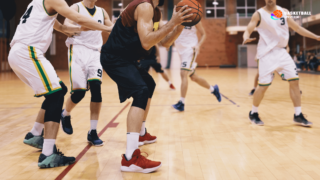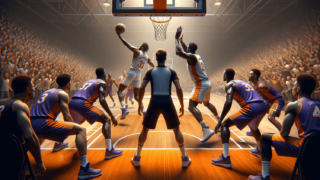
Understanding the Basketball Ejection Rule
Written by: Basketball Universe
Last updated:

For basketball enthusiasts and curious newcomers alike, one of the most exciting and controversial aspects of the game is the ejection rule. While not as frequent as your thrilling dunks or perfectly executed threes, the moment a player or coach is ejected from a game packs the drama and tension we all love. In this blog post, we’ll be diving into the intricacies of the basketball ejection rule, providing you with real-life examples and shedding light on the ins and outs of this rule that can change the course of a game. So, whether you’re an experienced fan or an aspiring referee, grab your whistle and let’s embark on this entertaining journey to “Understanding the Basketball Ejection Rule.”
Understanding the Basketball Ejection Rule
The basketball ejection rule is enforced when a player, coach, or team staff member commits an action deemed severely unsportsmanlike or detrimental to the game. Ejections commonly occur when a player receives two technical fouls, a flagrant foul type 2, or a combination of a technical and flagrant foul type 1. Coaches or staff can also be ejected for multiple technical fouls or extreme misconduct. When ejected, the individual must leave the playing area and cannot return to participate or observe the remainder of the game.
Technical Fouls: When Things Get Too Heated
A significant part of understanding the basketball ejection rule involves the concept of technical and flagrant fouls. A technical foul is a violation that doesn’t involve physical contact but is deemed unsportsmanlike, disruptive or abusive to opponents, teammates, coaches, or officials. Technical fouls are often assessed for excessive arguing, inappropriate language, delaying the game or showing disrespect towards the game or its participants. Let’s take a closer look at the technical fouls and their role in basketball ejection.
What Constitutes a Technical Foul
Some common scenarios that can lead to a technical foul include:
- Arguing excessively with a referee or disputing a call
- Disrespectful language or gestures directed towards an opponent, teammate, coach or official
- Deliberate delay of the game, such as failure to leave the court when substituted or excessive timeouts
- Intentionally hanging on the rim or slapping the backboard (with some exceptions for safety)
- Illegal substitution or entering the game without permission from the scorer’s table
- Violations committed by a team’s coach or bench members disturbing the flow of the game
Consequences of Technical Fouls
A single technical foul awards one free throw and possession of the ball to the opposing team. If a player, coach, or team staff member accumulates two technical fouls in a single game, it results in automatic ejection, invoking the basketball ejection rule. The accumulation of technical fouls also has consequences beyond a single game, as an excess of technical fouls in a season or playoffs may result in fines or suspensions.
Flagrant Fouls: When Aggressiveness Crosses the Line
While physical contact is a natural part of basketball, there are instances where it becomes excessive, unnecessary or dangerous. This is where flagrant fouls come into play. A flagrant foul is assessed when a player demonstrates unnecessary or excessive force on an opponent or engages in dangerous, harmful, or potentially injurious contact. Flagrant fouls are divided into two categories: type 1 and type 2.
Flagrant Foul Type 1
A flagrant foul type 1 is any contact committed by a player against an opponent that is deemed unnecessary but not excessive. Examples of actions that might result in a flagrant foul type 1 include:
- Swinging an elbow above shoulder level towards an opponent
- Holding, pushing, or grabbing an opponent excessively when the ball is not in play or after a whistle
- Hitting an opponent excessively during a scramble for a loose ball
Upon review, if a foul is marked as flagrant foul type 1, the opposing team is awarded two free throws and possession of the ball. A player who accumulates a combination of a technical foul and a flagrant foul type 1 or two flagrant fouls type 1 within a single game is ejected.
Flagrant Foul Type 2
A flagrant foul type 2 occurs when a player commits contact with an opponent that is deemed unnecessary and excessive. Such actions are clearly outside the realm of acceptable basketball rules and are often indicative of a disregard for the safety and well-being of the other players. Examples of contact that may warrant a flagrant foul type 2 include:
- Viciously striking an opponent in the head, neck, or face
- Violently shoving or pushing an airborne player
- Deliberately undercutting an opponent to cause them to fall
- Engaging in any dangerous, excessively forceful, or severely unsportsmanlike act
If a player is assessed a flagrant foul type 2, they are immediately ejected from the game. The opposing team is also awarded two free throws and possession of the ball.
The Ejection Process: A Quick Glimpse
Understanding the process of ejection is another important aspect of the basketball ejection rule. Here is the step-by-step procedure when a player, coach, or team staff member is ejected from a game:
- An official calls a technical, flagrant foul type 1, or flagrant foul type 2 on a player, coach, or team staff member.
- If warranted, the referee will discuss the call with other officials or review the incident using the available video replay system.
- After confirmation or revision of the call, the announcement of the foul and the ejection are made by the game announcer or referee.
- If the offending player has not already been substituted, the coach has 30 seconds to replace them with a substitute player.
- The ejected individual must leave the playing area (including the court and bench) and is not permitted to return for the remainder of the game. In most cases, they must also leave the arena or venue entirely.
- After the game, the league may review the incident and determine if further disciplinary action is warranted, such as fines or suspensions.
Noteworthy Ejections in Basketball History
While ejections are relatively rare in professional basketball, there have been several memorable instances where the basketball ejection rule has come into play. Let’s relive a few of these thrilling moments:
Dennis Rodman’s Kick
In a 1997 game against the Minnesota Timberwolves, Chicago Bulls’ Dennis Rodman was ejected after intentionally kicking a courtside camera operator. He was assessed a flagrant foul type 2 and served a subsequent 11-game suspension.
Rasheed Wallace’s Record-Breaking Technicals
Rasheed Wallace, known for his fiery nature on the court, set an NBA record for the most technical fouls in a single season (41) during the 2000-01 season with the Portland Trail Blazers. This record evidences that those who challenge the basketball rules cannot escape the ejection rule or its consequences indefinitely.
Tim Duncan’s Laugh
One of the more unusual ejections occurred in a 2007 game between the San Antonio Spurs and the Dallas Mavericks. Spurs legend Tim Duncan was ejected by the referee for merely laughing while sitting on the bench. While this may be an odd exception to the basketball ejection rule, it serves as a reminder that even seemingly harmless actions can result in ejection if deemed unsportsmanlike.
These examples highlight that while ejections can happen for a variety of reasons, the basketball ejection rule is in place to maintain sportsmanship, safety, and the spirit of the game.
Preventing Ejections: Sportsmanship and Respect
In truly grasping the basketball ejection rule, it’s important to recognize the value of sportsmanship and respect for the game. By adhering to the principles of good sportsmanship and maintaining a respectful demeanor both on and off the court, players and coaches can reduce the likelihood of being ejected from a game. Let’s discuss some best practices for maintaining sportsmanship and fostering a positive atmosphere in the world of basketball.
Respecting Officials and Opponents
Remember that officials are responsible for enforcing the rules of the game and ensuring a fair playing environment. It’s essential to treat officials, as well as opponents, with respect and dignity. While disagreements might occur, avoid arguing or using offensive language. Instead, calmly communicate your concerns or let your team captain or coach handle the discussions with officials.
Playing with Integrity
Committing to a clean style of play with an emphasis on skill and teamwork highlights the game’s true competitive spirit. Be mindful of your actions on the court, avoiding dangerous or unnecessary contact with opponents. By prioritizing your own skillful play and team success, you can focus on enjoying the game, which benefits everyone involved.
Staying Cool Under Pressure
Emotions can undoubtedly run high during intense basketball games, but it’s crucial to maintain composure even in the most high-stakes situations. Take deep breaths, visualize positive outcomes or even take a quick break when feeling overwhelmed. By managing your emotions effectively, you minimize the risk of getting caught up in confrontations or actions that could lead to ejections.
Famous Ejections That Changed the Course of a Game
On occasion, a high-profile ejection can dramatically impact the outcome of a contest. Here are a few instances where an ejection left an indelible mark on a game:
An Ejection that Fueled a Team’s Turnaround
In Game 5 of the 2016 NBA Western Conference Finals, Golden State Warriors’ Draymond Green was ejected after receiving a flagrant foul type 1 for an altercation with Oklahoma City Thunder’s Steven Adams. This ejection inadvertently helped spark a thrilling comeback by the Warriors, who eventually went on to win the series and advance to the NBA Finals.
Coaching Ejections and Leadership Lessons
In a 2017 game, Golden State Warriors’ head coach Steve Kerr received two technical fouls for protesting calls and was ejected from the match. However, this incident served as a valuable leadership lesson for the players, who rallied together in Kerr’s absence and subsequently won by 46 points.
While these examples show that ejections can have unpredictable consequences, they emphasize the importance of the basketball ejection rule in maintaining the integrity and competitive balance of the game.
FAQ: Delving Deeper into the Basketball Ejection Rule
We understand that you may have some lingering questions or require clarifications about the basketball ejection rule. To help you fully comprehend this rule, we have compiled a list of frequently asked questions and short, insightful answers to further guide you.
What is the penalty for technical fouls?
For each technical foul, the opposing team is awarded one free throw, and they maintain possession of the ball afterward.
What happens if a player receives a flagrant foul type 1 and a technical foul in the same game?
If a player receives a flagrant foul type 1 and a technical foul in the same game, they are ejected according to the basketball ejection rule.
What is the rationale behind the basketball ejection rule?
The basketball ejection rule aims to promote sportsmanship, ensure the safety of players, and maintain the integrity and competitive balance of the game.
How can a coach be ejected from a basketball game?
A coach can be ejected from a game if they accumulate two technical fouls or engage in extreme misconduct that warrants an immediate ejection.
What is the difference between a technical foul and a flagrant foul?
A technical foul involves a non-contact violation that is unsportsmanlike or disruptive to the game. A flagrant foul involves excessive, dangerous, or harmful physical contact that is unnecessary or unacceptable in regard to basketball rules.
Is a player automatically ejected if they receive a flagrant foul type 1?
No, a player is not automatically ejected for receiving a flagrant foul type 1. However, if they accumulate two flagrant fouls type 1 in the same game or a flagrant foul type 1 in addition to a technical foul, they will be ejected.
Can a referee be ejected from a basketball game?
No, a referee cannot be ejected from a basketball game, as they are responsible for officiating and ensuring the enforcement of the game’s rules. However, if a referee’s conduct is deemed unprofessional or inappropriate, there can be repercussions from the league, such as disciplinary actions or suspensions.
What is the main reason players and coaches are ejected from basketball games?
The most common reason for ejections in basketball games is the accumulation of two technical fouls. Also, a flagrant foul type 2 or a combination of a technical foul and a flagrant foul type 1 can lead to an ejection.
Are fouls that lead to ejections reviewed by referees?
Yes, referees can discuss fouls with other officials or review video replay footage to confirm or revise a foul call, including those that may lead to an ejection.
Can ejected players or coaches appeal their ejections?
Players and coaches cannot immediately appeal an ejection during a game. However, the league may review incidents that led to ejections, and the ejected individuals may dispute disciplinary actions, such as fines or suspensions, imposed post-game by the league.
Featured Posts
- No pillar pages found.





